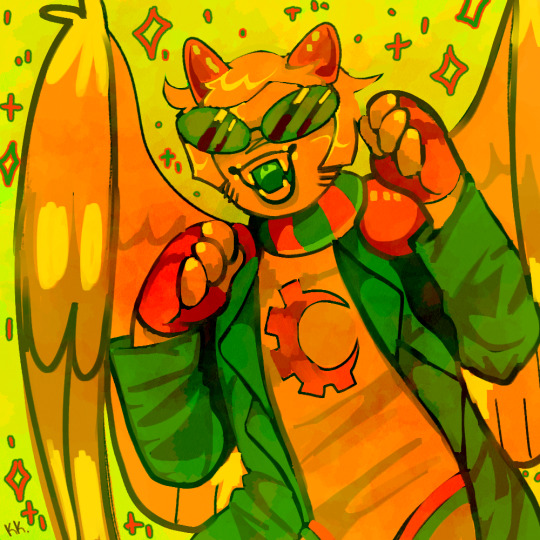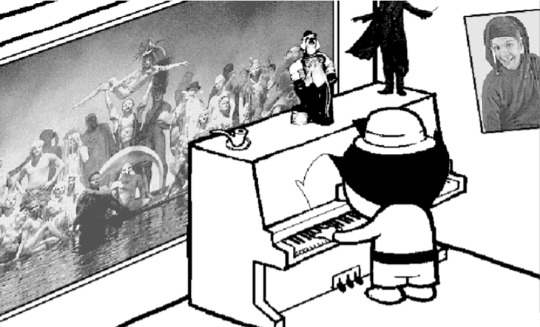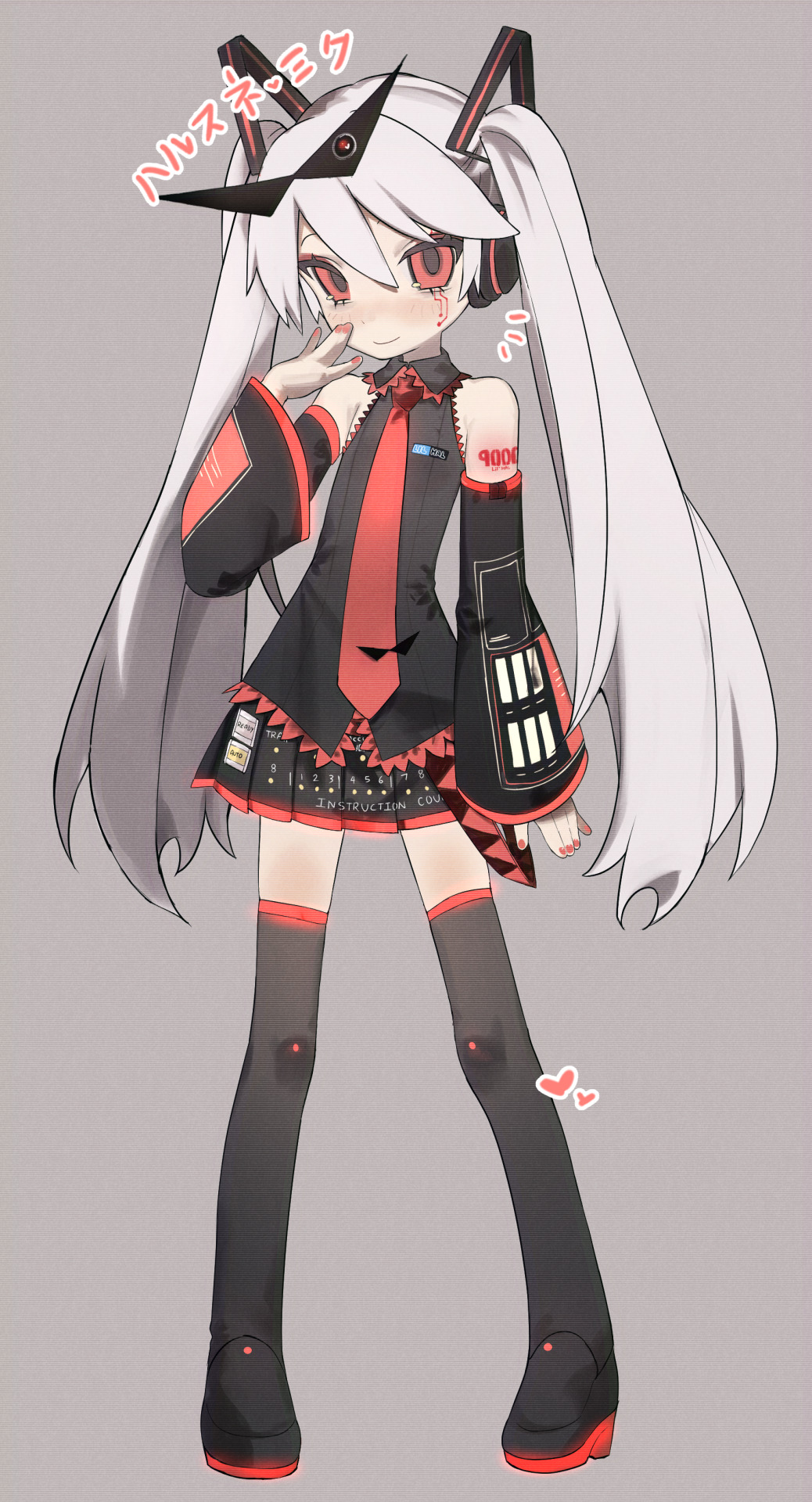Text

HEY HEY CAPTCHAVOGE ZINEEEE!!!!!!!!
-> HEREEEE <-
23 notes
·
View notes
Text

aradia practice doodle
72 notes
·
View notes
Text

I’ve been practicing writing in New Alternian lately. Transcription in the image description, unless I somehow fucked up a letter without noticing.
0 notes
Text

just davepeta dropping a sick purr beat !!!
114 notes
·
View notes
Text
Harlequin Anger vs Jester Ennui - Color as John Egbert’s Emotions
Week 2 Retrospective
John Egbert is the silliest little guy, but we’re starting to see hints of what he’s feeling beneath the surface. Looking at the themes of the comic so far, my current theory is that the colorful elements in the comic are the things that make John feel strong emotions - both good and bad - while the monochrome elements represent what makes John feel bored and frustrated.
Analysis below the cut - about 2,200 words.
‘A familiar note is produced. It's the one Desolation plays to keep its instrument in tune.’ (p.82)
Desolation has two, related meanings - one is loneliness, grief, and lack of companionship, while the other is ruin, emptiness and destruction. The first meaning is John’s current mental state, while the second is the suburb he lives in. The majority of what’s surrounding John is entirely monochrome, and so is John himself. We also learn from the narration on p.82 that ‘something feels missing from [John’s] life’ and that he has a sense ‘not of mirth, but of lack’. I think he spends a lot of time going through the motions - poking at things in his room without settling to anything, wandering up and down the stairs when his dad is occupied - but his life is the same day in and day out, and he struggles to inject any excitement into his life, or even any anger at the situation he’s trapped in.
I think it’s extremely notable that almost everything relating to John’s family is monochrome. In addition to the house as a whole, the portraits of his dad and nanna are monochrome, as are the gifts and cakes from his dad, the car outside, and most importantly the piano. I don’t think John hates his father, but I think he struggles to connect with him or feel close to him. Ignoring page 72’s peanut ambiguity, the worst we hear about Dad is that he will ‘monopolize hours of [John’s] time’ (p.30) and ‘can be a real cornball’ (p.49), which is a big contrast to him calling Betty Crocker his ‘arch nemesis’ (p.48).
Therefore, John’s dad is an inconvenience, not a threat. John might know intellectually that his dad loves him - ‘the old man really came through this time’ (p.19), as well as the kind fatherly notes left on John’s birthday presents (p.12, p.55) - but I think he can’t make the leap to actually caring about his dad in return or enjoying his company.

John is a gifted piano player, and gives us a ‘haunting piano refrain’ (p.77). Him being a musician ties back into the act title - ‘the note desolation plays’ uses the language of music, something so often filled with emotion, to describe a lack of it. Given that, of course the piano is monochrome. Perhaps John even sees the piano as the source of his problems, or at least representative of them.
I noted at the time that it was strange John hadn’t listed piano among his interests when it’s clearly something he’s spent a lot of time on, and now I think it’s something that was taught to him as a kid by either his dad or nanna. He’s good at it, but he’s so disconnected from family life that it no longer brings him any joy, it’s just a hangover from his childhood. ‘Haunting’ makes me think it was his nanna who taught him - now every time John plays, he’s haunted by her memory (or even her literal ghost). Possibly her death is what made John disconnect from the hobby, especially with ‘desolation’ relating to grief.
On page 4, we get our first glimpse of the outside. The blue sky shot through with the brown tree is the largest splash of color in John’s room. The promise of the outside world is extremely colorful, and we know John wants to go there - the window reflected in John’s glasses on page 28 as he grins excitedly is a clear visual indication of that. Yet when we finally see it, the outside isn’t all color - the grass, sky, trees and flowers all are, but the man made aspects such as the driveway, tire swing, and other houses in the neighborhood are gray and dull.
Page 82 gives us the dramatic moment of John removing his clever disguise and gazing up at the sky. It’s the first time we see the sun and the uninterrupted expanse, and it’s framed like it’s significant for John, too. I don’t think it’s literally his first time stepping outside (you can’t tell me his dad didn’t push him on that tire swing as a kid) but I think it’s the moment he realizes that leaving his literal house doesn’t mean he’s not stuck - the neighborhood is just more of the same, and whatever restrictions John’s working within mean he can’t go any further than this. A front yard is legally part of a house, and the reality of the outside doesn’t excite him as much as the idea of it.

And then there’s the clowns. The one aspect of his dad that really gets John going; the harlequin portraits in the hallway and living room that Dad brought back from clown con are bright, obnoxious, and impossible to ignore. Interestingly, the ones in the study are black and white - perhaps John is okay with the clown pictures in the study, because that’s explicitly his dad’s space, but he doesn’t like the ones in the main area, because they make him feel like the house is fully his dad’s, not a shared space they could decorate together.
This is pure speculation, but I don’t think John has ever moved house. I get the impression that he grew up in this house, which is his dad’s now and was perhaps originally his nanna’s, and has never known a world outside of this specific neighborhood. Because John’s been there since he was born, it’s never crossed his dad’s mind that John might want to, say, put his Little Monsters poster in the living room - hence why that gift was left in John’s bedroom, while the harlequin doll is allowed to be downstairs.
Speaking of John’s room, it’s definitely not an oasis of color within the house. In our first shot of the room, we see six splashes of color, including the outside and John’s shirt - comparable to the living room (six including John’s shirt and hat) and study (five including the outside and John’s hat). A full three of the colorful elements in John’s room are related to Sburb, which in both the visuals and text is the thing John’s by far the most excited about right now, but I’ll circle back around to this.
John’s magic chest, magician’s hat, blood capsules, and copies of Colonel Sassacre’s and Wise Guy are all colorful too, but other prank elements - fake arms, beaglepuss, handcuffs, sword, smoke pellets) are all monochrome. This one’s tough, but my best guess is that John feels conflicted about his interest in pranks because it’s so similar to his dad’s interest, and perhaps even that the monochrome items are things John’s dad bought for him for past birthdays and holidays, while the colorful ones are things John got for himself.
John’s shirt is also worth mentioning here. John’s ambivalence with the house extends to himself, and kids often don’t have a lot of control over their appearance. He probably doesn’t choose his own clothes or glasses or haircut, and he definitely can’t go out and get a tattoo of Slimer or anything like that, so it’s very telling that wearing a shirt with a favorite movie on it is the one way John can actually connect to himself.
That said, all the movie posters in his room are monochrome, which I’ll again circle back to. One exception is the close up of the Problem Sleuth poster (p.11), which is mostly monochrome, but has four kernels of colorful candy corn. I love this detail so much. It’s a fun reference to Hussie’s previous work and suggests that the candy corn gags in Problem Sleuth are John’s favorite part, which feels right for him. I wonder if John will use candy corn for a prank at some point in reference to this game he likes. I also noticed that the menu bar at the top of the web page also contains four kernels of candy corn - is this just because Problem Sleuth is Hussie’s most notable work, or could it be a clue for Homestuck too?

The most colorful and complex elements of the comic so far are the screens. We see John’s computer, which as a physical object is monochrome but which lights up to a brightly colored world of chums, flashing programs, desktop icons and stunning feats of graphic design, including things John loves (Slimer) and things that make him boil with rage (coding). We also get to see a very green tinted TV commercial in the living room, and a full color clip of Con Air linked from page 20.
All this makes me wonder if John’s list of interests is chronological. First on his list (p.4) is ‘really terrible movies’, and many of his favorite titles are from the 1980s and 90s, meaning he probably grew up with them. I think he still loves watching and discussing them, but - given that movies are a fairly passive medium - just the reminder of them on his wall isn’t enough to take him out of his own head anymore. He then got into programming, the paranormal, magic, and video games in sequence, meaning that the final two are his most active interests right now, and the ones to which the most time and color are devoted. In this way, the casual end to the list ‘You also like to play GAMES sometimes’ reads like intentionally downplaying something that’s actually really important, the sarcasm of ‘sometimes’ revealed later when we learn that John has ‘put countless manhours into this assortment of quality titles’ (p.31).
Unlike the movie posters, most of the games on John’s CD rack are in color, and unlike movies, games can offer an interactive, immersive experience. Games are enticing to John right now because they’re the best escape from a monotonous, suburban life that John has access to. He’s played his current collection time and time again (to the point that Bard Quest and Problem Sleuth have lost their color), and that’s why he’s so desperate for Sburb to arrive, and why the colorful reminders of Sburb are all over his room.
I think there’s a very real question of whether Sburb will live up to John’s expectations. At only one letter away from Suburb, it’s a clear reminder that video games don’t actually take John away from the life he’s stuck in, they’re a cosmetic alteration at best - and if the themes of the game are too close to John’s real life problems, he won’t find that escapism. So while I’d love to see a version of this comic where John finally starts playing Sburb and the whole screen immediately explodes into color, I’m not sure it’ll be that easy.

Finally, there’s the meta elements of the story. The captchalogue card overlay and strife specibus are pink and green respectively, and other elements that pop up (indication of whether or not we’ve got John’s name right, the cake turning blue when selected, the blinking green telling us we can put the poster on the wall, etc) are colorful too. The hammer that John allocates to his strife specibus is monochrome, however, which fits really well with John allocating it on TG’s instructions and not knowing that the allocation is permanent. If he’d known, he would have chosen something he felt more strongly about.
Interestingly, the narrative text is black. I still don’t think we’re directly getting John’s perspective, I think that’s been filtered through a specific narrator who has a voice very different to John’s (based on John’s Pesterchum messages), but I don’t think John has any awareness of this. In contrast, he’s all too aware of his captchalogue deck and the artificial, needlessly complex limitations it imposes, and he visually reacts to us getting his name right or wrong.
If John were to somehow become aware of the narrative text, and have strong feelings about the way he’s being portrayed (or the fact that he’s being written about at all), perhaps it would change color? After all, when John talks to his friends, each of them has a defined color, perhaps relating to the different relationships he has with each friend, and different emotions arising from that. John doesn’t seem to always like his friends - he gets frustrated at the notifications, and spends his whole conversation with TT already trying to leave - but he still replies and actively engages with them, a massive contrast to how he is with his dad.
‘His riddle is Absence itself.’ (p.82)
To conclude, I do find it interesting that the brightest colors in the comic are the things that are most natural (grass, flowers) and the things that are most artificial (screens, the abstract concept of the inventory) while everything in the middle is black and white. This fits with the idea of color being about both extremes at once, and the idea that John wants a chance to explore both the real and virtual worlds.
The meta function of color is to make certain visual elements stand out to the audience and tell us they’re worth paying attention to. From a purely functional perspective, it makes sense that the things most important to John would also be highlighted to us. But given the theme of lack and emptiness, the absence of color is just as important. And as the comic is already playing so much with the meta, I think that’s the most helpful starting point for analysis.
23 notes
·
View notes
Text
John's Clever Disguise: Final Stats
John Egbert first donned his CLEVER DISGUISE on p.46 (April 18, 2009).
John Egbert finally unequipped his CLEVER DISGUISE on p.89 (April 27, 2009).
In the first 89 pages, we see 44 unique instances of John wearing his CLEVER DISGUISE.
In the first 89 pages, we see 37 unique instances of John without his CLEVER DISGUISE.
By page count, John was wearing his CLEVER DISGUISE for 47% of the first 89 pages of Homestuck [accounting for temporary removal on p.82].
In real time, John was wearing his CLEVER DISGUISE for 64% of the first 2 weeks of Homestuck.
By unique instances, CLEVER DISGUISE John represents 54% of all the times we've seen John.
CLEVER DISGUISE, you will be forever in my heart.
25 notes
·
View notes
Text
Apple Juice
Definition: Howie Mandel's gross monster piss.
Source.
1 note
·
View note
Text
Faygo
Definition: A rude, sticky elixir.
Source 1. Source 2. Source 3. Source 4.
1 note
·
View note
Text

color harmony left the chat but I had soo much fun drawing this
expect an speedpaint soon 👀
207 notes
·
View notes
Text

it's spring and i like to listen to the peepers peepin' c:
1K notes
·
View notes
Text


the girls ever <3
2K notes
·
View notes
Text

she is like a mythological figure 2 me
204 notes
·
View notes
Text

everyone should have their own personal miku sona etc etc
171 notes
·
View notes
Text

HOT PINK PRINCESS BERRYBOO SQUIDDLE BASS AVALIABLE NOW ONLY $599!!!!!!!!
147 notes
·
View notes

